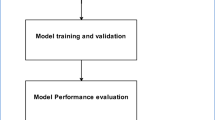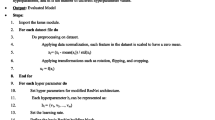Abstract
Prostate cancer (PCa) is found to be the second most common cause of death in men after lung cancer, making it necessary to diagnose as early as possible. The major modality used for PCa detection is Magnetic resonance imaging (MRI), as it is acquired in a radiation-free area, making its visibility better. So, developing MRI-based Computer-aided diagnosis (CAD) systems for PCa is becoming one of the most dynamic areas of research these days. The traditional approaches used to examine PCa are mainly manual and consume much time. CAD system thus reduces the manual approach employing different image processing approaches, thereby increasing the accuracy of PCa diagnosis. This paper presents a deep learning-based methodology named Prostate Classification Network (PC-Net) for the classification of cancer from the T2-weighted (T2w) MRI modality. The proposed model gave an accuracy of 97.12%, sensitivity of 98.18% and specificity of 95.67%.














Similar content being viewed by others
Data availability
Data will be made available on reasonable request.
References
Rawla P (2019) Epidemiology of prostate cancer. World J Oncol 10(2):63
Sung H, Ferlay J, Siegel RL, Laversanne M, Soerjomataram I, Jemal A, Bray F (2021) Global cancer statistics 2020: GLOBOCAN estimates of incidence and mortality worldwide for 36 cancers in 185 countries. CA: Cancer J Clin 71(3):209–49
Hariharan K, Padmanabha V (2016) Demography and disease characteristics of prostate cancer in India. Indian J Urol 32(2):103–108. https://doi.org/10.4103/0970-1591.174774
Division of cancer prevention and control, centers for disease control and prevention: what is prostate cancer? Available at: https://www.cancer.gov/types/prostate/patient/prostate-treatment-pdq. Accessed 16 Feb 2023
Ilic D, Neuberger MM, Djulbegovic M, Dahm P (2013) Screening for prostate cancer. Cochr Database Syst Rev 2013(1):CD004720. Published 2013 Jan 31. https://doi.org/10.1002/14651858.CD004720.pub3
Smeenge M, de la Rosette JJ, Wijkstra H (2012) Current status of transrectal ultrasound techniques in prostate cancer. Curr Opin Urol 22(4):297–302
Kasivisvanathan V, Rannikko AS, Borghi M, Panebianco V, Mynderse LA, Vaarala MH, Briganti A, Budäus L, Hellawell G, Hindley RG, Roobol MJ (2018) MRI-targeted or standard biopsy for prostate-cancer diagnosis. N Engl J Med 378(19):1767–1777
Juneja M, Saini SK, Gupta J, Garg P, Thakur N, Sharma A, Mehta M, Jindal P (2021) Survey of denoising, segmentation and classification of magnetic resonance imaging for prostate cancer. Multimed Tools Appl 22:1–51
Albawi S, Mohammed TA, Al-Zawi S (2017) Understanding of a convolutional neural network. In 2017 International Conference on Engineering and Technology (ICET). pp. 1–6
Lemaitre G, Massich J, Martí R, Freixenet J, Vilanova JC, Walker PM, Sidibé D, Mériaudeau F (2015) A boosting approach for prostate cancer detection using multi-parametric MRI. InTwelfth international conference on quality control by artificial vision 2015. Int Soc Optics Photonics 9534:95340A
Trigui R, Mitéran J, Walker PM, Sellami L, Hamida AB (2017) Automatic classification and localization of prostate cancer using multi-parametric MRI/MRS. Biomed Signal Process Control 31:189–198
Reda I, Khalil A, Elmogy M, Abou El-Fetouh A, Shalaby A, Abou El-Ghar M, Elmaghraby A, Ghazal M, El-Baz A (2018) Deep learning role in early diagnosis of prostate cancer. Technol Cancer Res Treat 17:1533034618775530
Stanzione A, Cuocolo R, Cocozza S, Romeo V, Persico F, Fusco F, Longo N, Brunetti A, Imbriaco M (2019) Detection of extraprostatic extension of cancer on biparametric MRI combining texture analysis and machine learning: preliminary results. Acad Radiol 26(10):1338–1344
Jin J, Zhang L, Leng E, Metzger GJ, Koopmeiners JS (2021) Bayesian spatial models for voxel‐wise prostate cancer classification using multi‐parametric magnetic resonance imaging data. Stat Med
Provenzano D, Melnyk O, Imtiaz D, McSweeney B, Nemirovsky D, Wynne M, Whalen M, Rao YJ, Loew M, Haji-Momenian S (2023) Machine learning algorithm accuracy using single-versus multi-institutional image data in the classification of prostate MRI lesions. Appl Sci 13(2):1088
Abraham B, Nair MS (2018) Computer-aided classification of prostate cancer grade groups from MRI images using texture features and stacked sparse autoencoder. Comput Med Imaging Graph 1(69):60–68
Yuan Y, Qin W, Buyyounouski M, Ibragimov B, Hancock S, Han B, Xing L (2019) Prostate cancer classification with multiparametric MRI transfer learning model. Med Phys 46(2):756–765
De Vente C, Vos P, Hosseinzadeh M, Pluim J, Veta M (2020) Deep learning regression for prostate cancer detection and grading in bi-parametric MRI. IEEE Trans Biomed Eng 68(2):374–383
Malibari AA, Alshahrani R, Al-Wesabi FN, Hassine SBH, Alkhonaini MA, Hilal AM (2022) Artificial intelligence based prostate cancer classification model using biomedical images. Comput Mater Contin 72:3799–3813
Liu G, Pan S, Zhao R, Zhou H, Chen J, Zhou X, Xu J, Zhou Y, Xue W, Wu G (2023) The added value of AI-based computer-aided diagnosis in classification of cancer at prostate MRI. Eur Radiol 1–13
Wang X, Yang W, Weinreb J, Han J, Li Q, Kong X, Yan Y, Ke Z, Luo B, Liu T, Wang L (2017) Searching for prostate cancer by fully automated magnetic resonance imaging classification: deep learning versus non-deep learning. Sci Rep 7(1):15415
Mehta P, Antonelli M, Ahmed HU, Emberton M, Punwani S, Ourselin S (2021) Computer-aided diagnosis of prostate cancer using multiparametric MRI and clinical features: a patient-level classification framework. Med Image Anal 1(73):102153
Leung KH, Rowe SP, Leal JP et al (2022) Deep learning and radiomics framework for PSMA-RADS classification of prostate cancer on PSMA PET. EJNMMI Res 12:76
Juneja M, Kaur Saini S, Kaul S, Acharjee R, Thakur N, Jindal P (2021) Denoising of magnetic resonance imaging using Bayes shrinkage based fused wavelet transform and autoencoder based deep learning approach. Biomed Signal Process Control 69:102844. https://doi.org/10.1016/j.bspc.2021.102844
Chollet F (2017) [IEEE 2017 IEEE Conference on Computer Vision and Pattern Recognition (CVPR) - Honolulu, HI (2017.7.21–2017.7.26)] 2017 IEEE conference on Computer Vision and Pattern Recognition (CVPR) - Xception: deep learning with depthwise separable convolutions, 1800–1807. https://doi.org/10.1109/cvpr.2017.195
Szegedy C, Vanhoucke V, Ioffe S, Shlens J, Wojna Z (2016) [IEEE 2016 IEEE conference on Computer Vision and Pattern Recognition (CVPR) - Las Vegas, NV, USA (2016.6.27–2016.6.30)] 2016 IEEE conference on Computer Vision and Pattern Recognition (CVPR) - rethinking the inception architecture for computer vision, 2818–2826. https://doi.org/10.1109/CVPR.2016.308
He K, Zhang X, Ren S, Sun J (2016) Deep residual learning for image recognition, 2016 IEEE conference on Computer Vision and Pattern Recognition (CVPR), pp. 770-778. https://doi.org/10.1109/CVPR.2016.90
Huang G, Liu Z, Van Der Maaten L, Weinberger KQ (2017) Densely connected convolutional networks. IEEE conference on Computer Vision and Pattern Recognition (CVPR) 2017:2261–2269. https://doi.org/10.1109/CVPR.2017.243
Liu S, Deng W (2015) Very deep convolutional neural network based image classification using small training sample size," 2015 3rd IAPR Asian Conference on Pattern Recognition (ACPR), pp. 730–734. https://doi.org/10.1109/ACPR.2015.7486599
Funding
The authors are grateful to the Ministry of Human Resource Development (MHRD), Govt. of India for funding this project(17–11/2015-PN-1) under Design Innovation Centre (DIC) sub-theme Medical Devices & Restorative Technologies.
Author information
Authors and Affiliations
Corresponding author
Ethics declarations
Conflict of interest
The authors declare that they have no conflict of interest.
Additional information
Publisher's Note
Springer Nature remains neutral with regard to jurisdictional claims in published maps and institutional affiliations.
Rights and permissions
Springer Nature or its licensor (e.g. a society or other partner) holds exclusive rights to this article under a publishing agreement with the author(s) or other rightsholder(s); author self-archiving of the accepted manuscript version of this article is solely governed by the terms of such publishing agreement and applicable law.
About this article
Cite this article
Juneja, M., Saini, S.K., Sharma, K. et al. Prostate classification network (PC-Net) for automated classification of Prostate cancer in Magnetic resonance imaging. Multimed Tools Appl (2024). https://doi.org/10.1007/s11042-024-19177-w
Received:
Revised:
Accepted:
Published:
DOI: https://doi.org/10.1007/s11042-024-19177-w




